Ancient Keepsakes: “Relate, remember, appreciate, preserve”
Ancient Keepsakes: “Relate, remember, appreciate, preserve”
With millions fleeing for their lives with just the clothes on their backs, prehistoric “keepsakes” take on new meaning
“Humans…are expected to live together with other persons (human and non-human), maintain good relations with them, and respect them to maintain world order and achieve well-being…” Who would you guess said such a thing recently? A politician, a religious figure, perhaps an animal rights activist, or a philosopher commenting on the horrific spasm of violence currently gripping Europe? From that same source, I read that humans maintain relations “through objects and materials, which also serve as economic and functional mediums.”* And what was that source? An article by prehistoric archaeologists describing their new discovery and interpretation. These statements, especially coming in what might be considered an unlikely context, touched me. Now I know, couched in academic language, why I accord my great-grandmother’s coffee set a place of honor in my home.
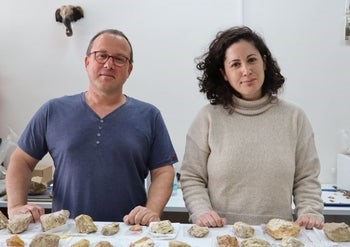
The connection came to me in the midst of the dreadful litany of hourly news reports the other day. The newscaster’s voice suddenly took on the lilt they use for human interest stories with a positive twist. Listeners were treated to a newly published report about prehistoric flint tools discovered at a site near Kibbutz Revadim in the Judean Lowlands, and what they meant.
In the article on which the report was based, published in the journal Scientific Reports, I read that the researchers, Bar Efrati and Prof. Ran Barkai from Tel Aviv University, and an international team, were able to discern that the prehistoric inhabitants of the area near Kibbutz Revadim collected and recycled flint tools that had been made, used, and discarded by their own ancestors. And it’s not because they had run out of good flint to mine in their neighborhood. After examining tools from a layer at the site, the researchers proposed that the hunter-gatherers who lived there collected these artifacts to bond to their predecessors’ memory.
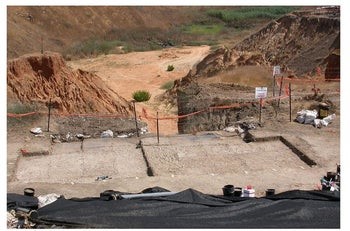
The ancients appreciated antiquities, too
Barkai and Efrati, of the Department of Archaeology and Ancient Near East Cultures at Tel Aviv University, and their colleagues, determined that 49 flint tools they examined had two separate lifecycles. In the first, the flint was mined and shaped into the desired tool – choppers for butchering bones, for example, and scrapers for working skins into clothing, shelter. and other uses. Eventually, they were abandoned. Years later, after accumulating a layer of patina – that’s a veneer an object acquires from chemical changes on an object over time – the inhabitants picked them up and reused them after removing the patina. The researchers determined that the flint objects they examined from Revadim had a double layer of patina; one developed after the first abandonment and the other appeared after the second.
The ancients exposed fresh flint, and then shaped a new working edge. But they preserved surfaces and scars from the old form. To Efrati, Barkai and their team, this meant that the ancients saw these tools as “memory objects” for the collectors to “relate, remember, appreciate and preserve the journey the item made until its point of collection.”*
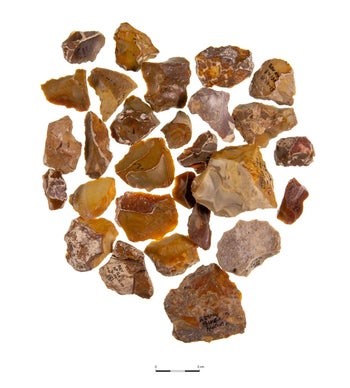
And lest you think that only prehistoric inhabitants of the Holy Land appreciated their ancestors, the findings conform to those at other sites in the Middle East and beyond.***
As Efrati and colleagues stated in a media interview: “Imagine a prehistoric human walking through the landscape 500,000 years ago, when an old stone tool catches his eye. The tool means something to him – it carries the memory of his ancestors or evokes a connection to a certain place. He picks it up and weighs it in his hands. The artifact pleases him, so he decides to take it ‘home’. Understanding that daily use can preserve and even enhance the memory, he retouches the edge for his own use, but takes care not to alter the overall shape – in honor of the first manufacturer. In a modern analogy, the prehistoric human may be likened to a young farmer still plowing his fields with his great-grandfather’s rusty old tractor, replacing parts now and then, but preserving the good old machine as is, because it symbolizes his family’s bond with the land.”**
On a shelf in my kitchen in Har Adar, Israel, sits an ornate, three piece coffee-serving set. Unlike the flint objects from Revadim, I don’t know where it came from – I doubt it arrived with my maternal grandmother from her ancestral home in Przasnysz or Sierpic, now Poland, in the late nineteenth century, which she left as a toddler with her family to escape persecution. I do know that by around 1912, the set was in their home in Cincinnati, Ohio (see the photo below), and by the looks of it that crowd of my great-greats seem to have done alright.
Millions who have been uprooted from their homes in our lifetime, with little but the clothes on their backs – from Ukraine now, and from Syria beginning a decade ago – don’t have the luxury of these musings. Neither did my husband Arik’s parents, who came to Israel as refugees from Hungary after the Holocaust. By the time I met them in 1980, his mother Tamar served dinner on a beautiful set of china. I still cringe at my ignorance in asking her at the time whether she had brought the set with her from Hungary. “Honey, when I came here, all I had was a knapsack,” she answered.
In my lifetime I’ve seen Persian carpets scattered across the floor of Ben Gurion Airport, belonging to Jews who fled Iran after the revolution in 1979. I’ve seen immigrants to Israel after the fall of the former Soviet Union, some arriving with pedigree dogs, violins and anything else they were allowed to take out. Now it’s the Ukrainian refugees, many arriving with just the clothes on their back. May they find their own inner strength and understanding hearts in others to preserve their lives and the lives of their children, set down new roots and know peace. May some semblance of “world order and well-being” as our archaeologists put it, be restored speedily and in our time.
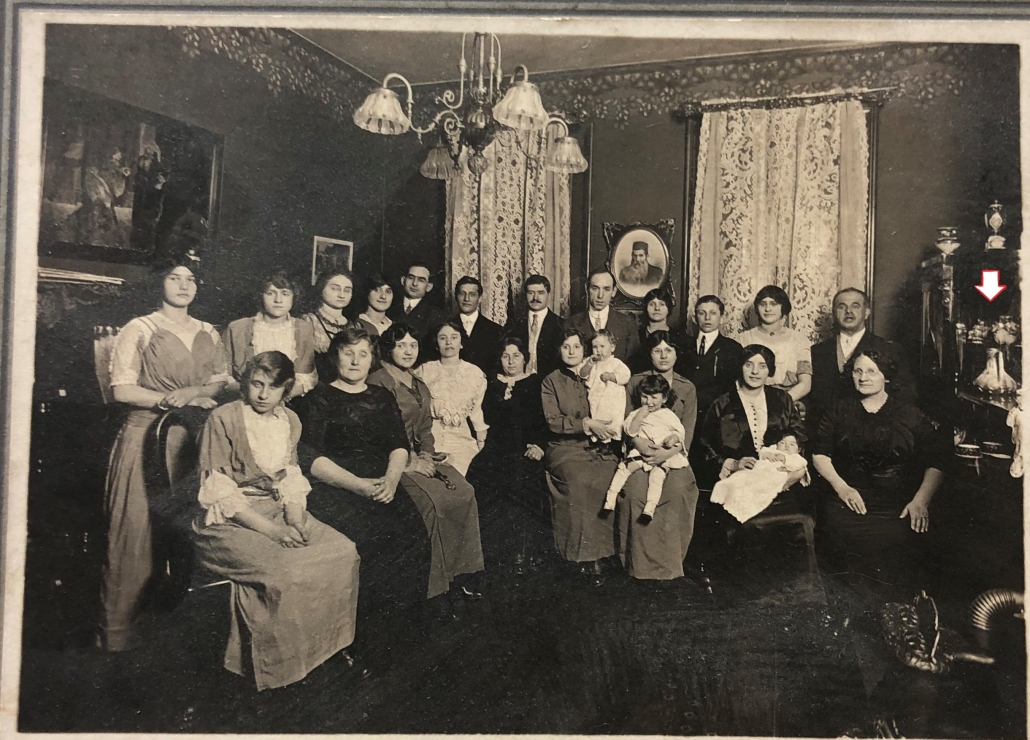
of her big sister Miriam. See the coffee set, marked with an arrow, at right.
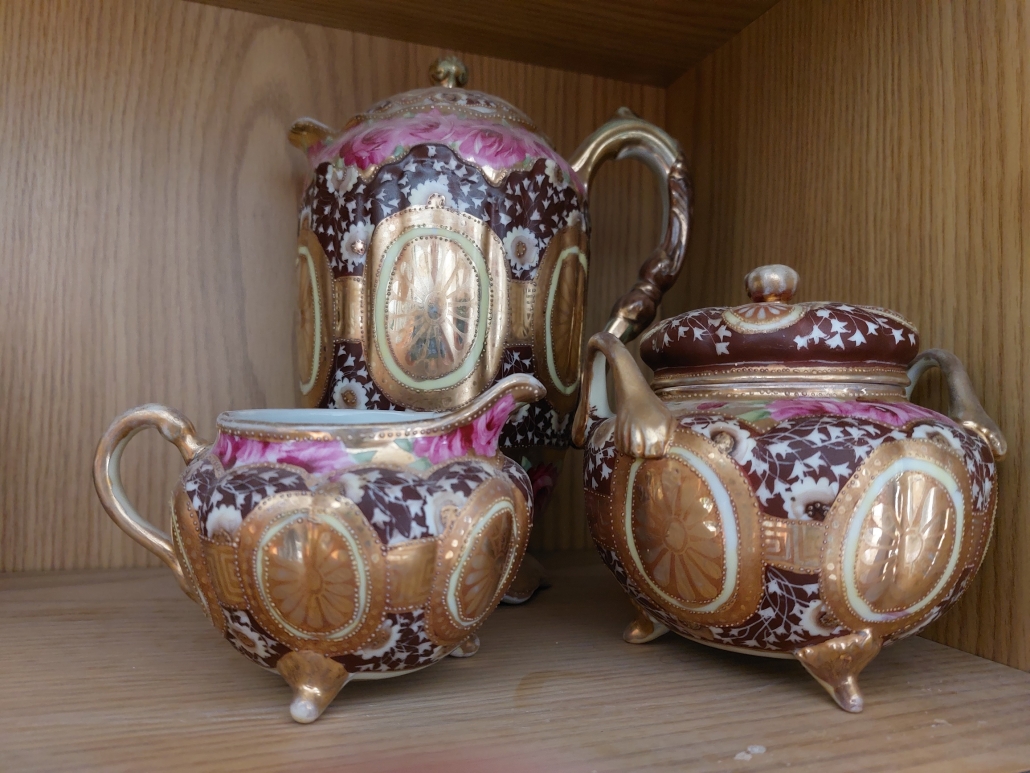

Want to know more?
*Efrati, B. et al. 2022. Function, life histories, and biographies of Lower Paleolithic patinated flint tools from Late Acheulian Revadim, Israel** DOI 10.1038/s41598-022-06823-2
** N.A. Collectors in the prehistoric world recycled old stone tools to preserve the memory of their ancestors.” **https://www.eurekalert.org/news-releases/945570,
Schuster, R. 2022. “Early Humans in Israel had a Special Reason to Recycle their Tools.” Haaretz, March 6, 2022. https://www.haaretz.com/archaeology/the-recycling-hominin-new-discoveries-about-ancient-tools-in-israel-1.10650381.
***Whyte, T. R. 2014. Gifts of the ancestors: Secondary lithic recycling in Appalachian Summit prehistory. American Antiquities 79, 679–696.
Thanks to expert Dr. Anna de Vincenz for setting the record straight: Mom always said it was a cocoa set but there goes another family myth, as Anna explained to me in a recent email: “A cocoa set would not have a sugar bowl and a milk jug or creamer! Cocoa was prepared with sugar and cream/milk in the kitchen and then served.“

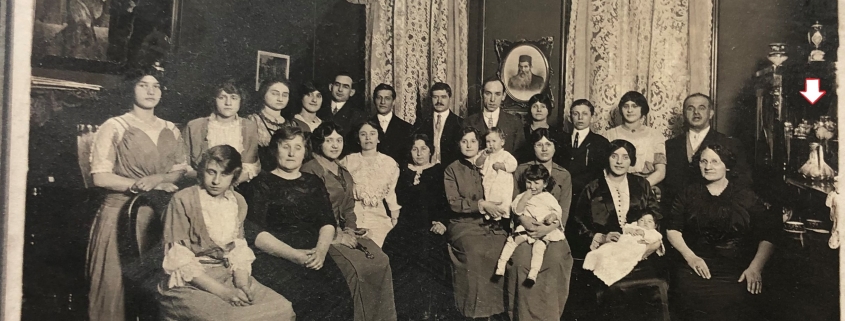
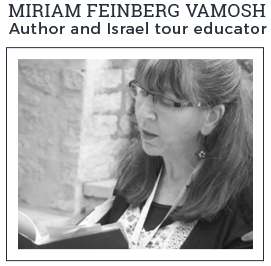
Wonderful blog, and sad too picturing the refuges with only their backpacks and memories of their homeland. I wonder how your ancestors managed to bring that cocoa set from some far away place without breaking it and then you carrying it to Israel! As always, I learn from you and appreciate your insight. Stay safe
Thank you! I couldn’t imagine that the family brought it from Europe when they came to the U.S., but I suppose if they left at the right time they could have brought “things” with them. I never thought of it in those terms.